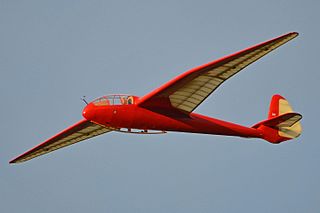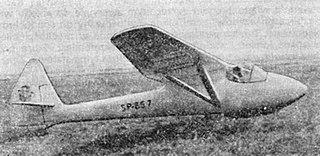Related Research Articles

The Slingsby T.30 Prefect is a 1948 British modernisation of the 1932 single-seat Grunau Baby glider. About 53 were built for civil and military training purposes.

The Slingsby T.13 Petrel was a British single-seat competition glider built by Slingsby Sailplanes just before World War II.

The Caudron C.800, at first also known as the Epervier is a French two seat training glider, designed and first flown during World War II and put into large scale post-war production. It was the dominant basic training glider with French clubs until the 1960s and several still fly.
The Bonomi BS.10 Ardea was an Italian single seat high performance glider, designed and built in the mid-1930s. Only one was built.
The Bonomi BS.14 Astore was a two-seat training and aerobatic glider, designed and built in Italy in 1935. Only one was constructed.
The Tedeschi E.T.186 was a simple, single seat training glider built in Italy and first flown in 1947. Only one was constructed.
The Teichfuss LT.12 Biposto was an Italian tandem seat primary glider designed by Luigi Teichfuss and flown in 1933.
The CAT 28BP was an Italian development of the licence built Dittmar Condor II into a high performance tandem two seat glider. Built in 1938, it anticipated the post-war, two seat Dittmar Condor IV and held the Italian national distance record for many years.
The RRG Urubu Obs, often known just as the RRG Obs, was a one-off, large, two or three seat glider designed for meteorological observations by Alexander Lippisch in Germany and first flown in 1932.
The Schneider Grunau 8 was a simple, two-seat trainer glider designed and built in Germany in the early 1930s.

The Caudron C.27 was a French biplane, a two-seat basic trainer which also competed successfully in the 1920s.
The Delanne 60-E.1 was a training sailplane, designed to enable pilots to graduate from their C certificate to the more demanding D. It was also capable of aerobatics. Only one was built but it was used from 1938 to the outbreak of war.

The Avia 41-P was a high performance French glider. Eric Nessler set many new national gliding records in one between 1934 and 1938.

The Avia 40-P was intended as an economical glider suitable for clubs and individuals but with a competitive performance capable of record setting. It was the most popular pre-war French glider, with more than forty built and it continued to set records immediately after World War II.
The Avia 50-MP was a French motor glider based on that of the Avia XV-A training glider. First flown in 1934, it was intended to introduce pilots to motor-gliders.
The Avia 60-MP was a French motor glider with a wing based on that of the Avia 32-E, an advanced training glider. It was intended as both an advanced trainer and as an atmospheric research aircraft.
The SEA.1 was a Belgian, multi-purpose, light twin engine monoplane flown in 1936. Only one was built; it was later converted into a single engine aircraft and used by the military.

The Albatros L 83 Adler was a small, fast transport aircraft for passengers, mail or other cargo, flown in Germany in 1931. Two were built.
The Caproni Ca.66 was an Italian night bomber designed to reequip the post-World War I Italian Air Force. Only two examples of the four-engined biplane were built.

The Warsztaty Szybowcowe Sokół was a 1930s Polish aerobatic sailplane. Ten were built and flown by Polish aeroclubs, participating in national and international events, until the outbreak of the Second World War.
References
- 1 2 3 4 5 "Le nouveaux planeur de grand performance Castel 34 "Condor"". Les Ailes (679). 21 June 1934.
- ↑ Bruno Parmentier (28 April 2001). "Castel C-34 'Condor'" . Retrieved 9 March 2016.
- 1 2 3 "La maquette du Castel 34" . Retrieved 10 March 2016.
- ↑ "A Nancy, à l'Aéro-club d'Est, on faite du vol à volie". Les Ailes (725): 12. October 1936.
- ↑ "(caption, image at page foot)". Les Ailes (801): 12. 9 May 1935.
- ↑ "Au plateau de Malzéville". Les Ailes (855): 11. 4 November 1937.
- ↑ "Vol sans moteur". Les Ailes (929): 12. 6 April 1939.
- ↑ "Vol sans moteur". Les Ailes (949): 14. 24 August 1939.